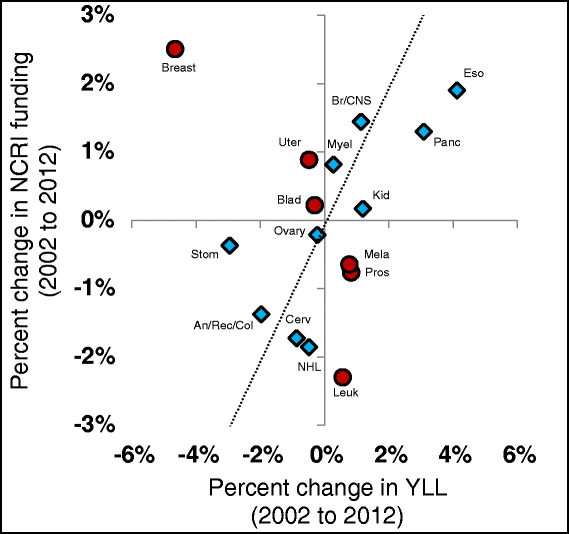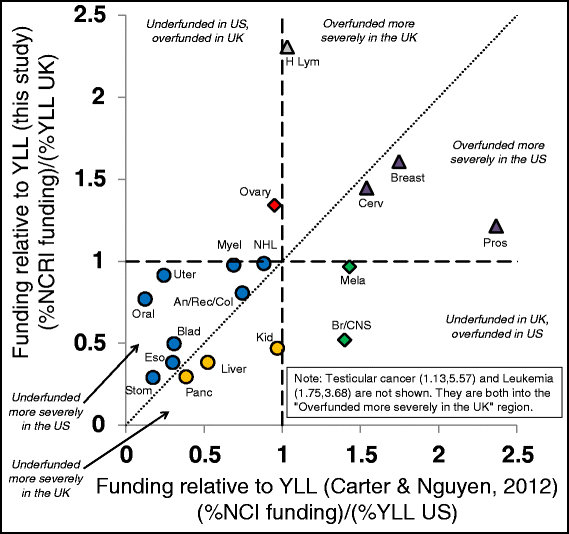An analysis of discrepancies between United Kingdom cancer research funding and societal burden and a comparison to previous and United States values
- PMID: 26526609
- PMCID: PMC4629288
- DOI: 10.1186/s12961-015-0050-7
An analysis of discrepancies between United Kingdom cancer research funding and societal burden and a comparison to previous and United States values
Abstract
Background: Ideally, the allocation of research funding for each specific type of cancer should be proportional to its societal burden. This burden can be estimated with the metric 'years of life lost' (YLL), which combines overall mortality and age at death.
Methods: Using United Kingdom data from 2010, we compared research funding from the National Cancer Research Institute to this YLL burden metric for 26 types of cancers in order to identify the discrepancies between cancer research funding allocation and societal burden. We also compared these values to United States data from 2010 and United Kingdom data published in 2005.
Results: Our study revealed a number of discrepancies between cancer research funding and burden. Some cancers are funded at levels far higher than their relative burden suggests (testicular, leukaemia, Hodgkin's lymphoma, breast, cervical, ovarian, prostate) while other cancers appear under-funded (gallbladder, lung, nasopharyngeal, intestine, stomach, pancreatic, thyroid, oesophageal, liver, kidney, bladder, and brain/central nervous system). United Kingdom funding patterns over the past decade have generally moved to increase funding to previously under-funded cancers with one notable exception showing a converse trend (breast cancer). The broad relationship between United Kingdom and United States funding patterns is similar with a few exceptions (e.g. leukaemia, Hodgkin's lymphoma, prostate, testicular cancer).
Conclusions: There are discrepancies between cancer research funding allocation and societal burden in the United Kingdom. These discrepancies are broadly similar in both the United Kingdom and the United States and, while they appear to be improving, this is not consistent across all types of cancer.
Figures




References
-
- Ferlay J, Soerjomataram I, Ervik M, Dikshit R, Eser S, Mathers C, et al. GLOBOCAN 2012 v1.0, Cancer incidence and mortality worldwide: IARC CancerBase No. 11. Lyon: International Agency for Research on Cancer; 2013. http://globocan.iarc.fr. Accessed 14 April 2014.
-
- Mitchell RJ, McClure RJ, Olivier J, Watson WL. Rational allocation of Australia’s research dollars: does the distribution of NHMRC funding by National Health Priority Area reflect actual disease burden? Med J Aust. 2009;191(11–12):648–52. - PubMed
Publication types
MeSH terms
Supplementary concepts
LinkOut - more resources
Full Text Sources
Other Literature Sources
Medical
Miscellaneous

